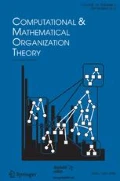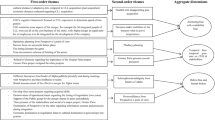Abstract
This article introduces the meso-unit theory of post-merger integration. The theory offers that the number of constituent work-units involved in an organizational merger has a greater detrimental effect on the time-to-integration than does the total number of constituent personnel involved. Its establishment is based on the results of controlled experiments conducted in a virtual laboratory. The simulation utilizes agent-based modeling software that encapsulates organizational behavior models such as the knowledge-based view of the firm, social and communication network theory, and CONSTRUCT theory. The software is configured for a two-organization merger and implements classic behavior dynamics to simulate communicative behavior of information-seeking actors. As a result, detailed micro- and macro-level data on the integration progress is available for examination, analysis and interpretation. The results give rise to the development of the meso-unit theory, which directs integration managers’ attention toward a key aspect of the integration that is often overlooked.







Similar content being viewed by others
References
Allen P, Ramlogan R, Randles S (2002) Complex systems and the merger process. Technol Anal Strateg Manag 14(3):315–329
Axelrod R (1986) An evolutionary approach to norms. Am Polit Sci Rev 80(4):1095–1111
Backström T, Döös M (2008) Relatonics as a key concept for networked organizations. In: Putnik GD, Cunha MM (eds) Encyclopedia of networked and virtual organizations, vol 3. Idea Group Inc, Hershey, pp 1367–1374
Blau PM (1970) A formal theory of differentiation in organizations. Am Sociol Rev 35(2):201–218
Blumer H (1969) Symbolic interactionism: perspective and method. Prentice-Hall, Englewood Cliffs
Bruner RF (2005) Deals from Hell: M&A lessons that rise above the ashes. Wiley, New York
Bryson J (2003) Managing HRM risk in a merger. Empl Relat 25(1):14–30
Capron L, Mitchell W (2013) Build, borrow, or buy: solving the growth dilemma. Harvard Business Press, Brighton
Carley KM (1986) Knowledge acquisition as a social phenomenon. Instr Sci 14:381–438
Carley KM (1990) Group stability: a socio-cognitive approach. In: Lawler E, Markovsky B, Ridgeway C, Walker H (eds) Advances in group processes: theory and research, vol 7. JAI Press, Greenwich, pp 1–44
Carley KM (2002) Smart agents and organizations of the future. In: Lievrouw LA, Livingstone S (eds) The handbook of new media social shaping and consequences of ICTS. Thousand Oaks, Sage, pp 206–220
Carley KM (2003) Dynamic network analysis. In: Breiger R, Carley KM, Pattison P (eds) Dynamic social network modeling and analysis: workshop summary and papers. National Research Council, Washington, DC, pp 133–145
Cyert RM, March JG (1992) A behavioral theory of the firm, 2nd edn. Blackwell, Oxford
Dooley KJ, Corman SR, McPhee RD, Kuhn T (2003) Modeling high-resolution broadband discourse in complex adaptive systems. Nonlinear Dyn Psychol Life Sci 7(1):61–85
Frantz TL, Carley K (2009) Computationally modeling the effect of organizational complexity on post-merger integration. Adv Mergers Acquis 8:79–101
Grant RM (1996) Toward a knowledge-based view of the firm. Strateg Manag J 17:109–122
Harrison J (2007) Why integration success eludes many buyers. Mergers Acquis J 42(3):18–21
Hviid M, Prendergast C (1993) Merger failure and merger profitability. J Ind Econ 41:371–386
Krackhardt D, Carley KM (1998) PCANS model of structure in organizations. In: Proceedings of the 1998 international symposium on command and control research and technology, June, Monterrey. Evidence Based Research, Vienna, pp. 113–119
Lauser B (2010) Post-merger integration and change processes from a complexity perspective. Baltic J Manag 5(1):6–27
Lin B-W, Hung S-C, Li P-C (2006) Mergers and acquisitions as a human resource strategy: evidence from US banking firms. Int J Manpow 27(2):126–142
March JG, Simon HA (1958) Organizations. Wiley, New York
Marks ML, Mirvis PH (2001) Making mergers and acquisitions work: strategic and psychological preparation. Acad Manag Exec 15(2):80–92
Mitleton-Kelly E, Mitleton E (2005) Co-evolutionary integration: a complexity perspective on mergers & acquisitions. LSE complexity research programme. http://www.psych.lse.ac.uk/complexity/Publications/icosspublications.html
Porter ME (1987) From competitive advantage to corporate strategy. Harv Bus Rev 65(3):43–59
Rice RE, Aydin C (1991) Attitudes toward new organizational technology: network proximity as a mechanism for social information processing. Adm Sci Q 2:219–244
Salancik GR, Pfeffer J (1978) A social information professing approach to job attitudes and task design. Adm Sci Q 23:224–253
Schweiger DM, DeNisi AS (1991) Communication with employees following a merger: a longitudinal field experiment. Acad Manag J 34(1):110–135
Simon HA (1957) Models of man: social and rational; mathematical essays on rational human behavior in a social setting. Wiley, New York
Stryker S (1980) Symbolic interactionism: a social structural version. Benjamin/Cummings Publishing, Menlo Park
Tsoukas H (1996) The firm as a distributed knowledge system: a constructionist approach. Strateg Manag J 17(S2):11–25
Wernerfelt B (1984) A resource-based view of the firm. Strateg Manag J 5:171–180
Author information
Authors and Affiliations
Corresponding author
Rights and permissions
About this article
Cite this article
Frantz, T.L. The meso-unit theory of post-merger integration. Comput Math Organ Theory 24, 99–111 (2018). https://doi.org/10.1007/s10588-017-9248-2
Published:
Issue Date:
DOI: https://doi.org/10.1007/s10588-017-9248-2




